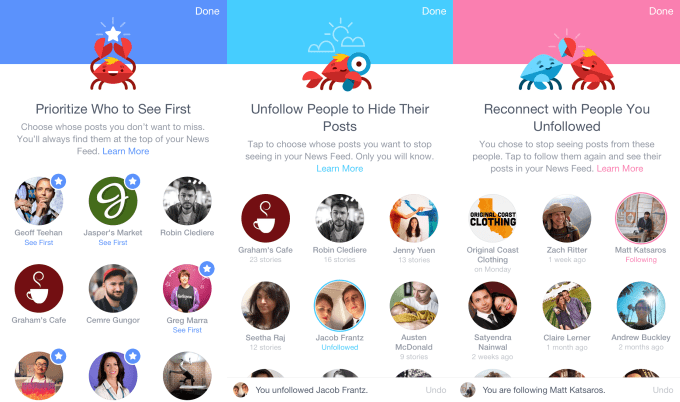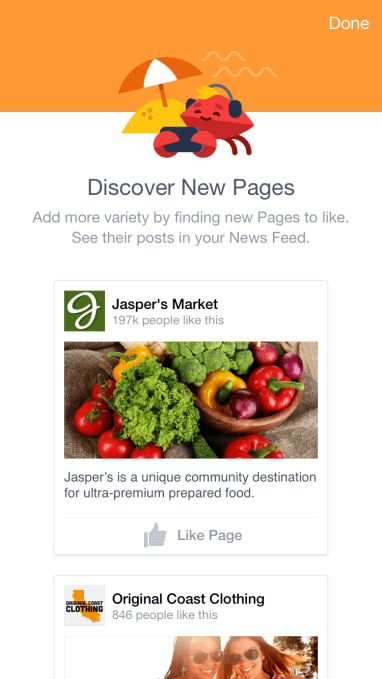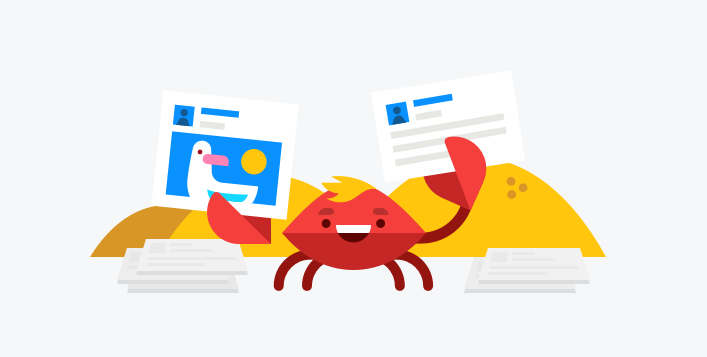“We know the algorithm isn’t perfect” News Feed Product Manager Greg Marra tells me. So to make sure Facebook stays entertaining and addictive, it’s giving users more direct control over what they see by revamping News Feed Preferences.
 Facebook is rolling out to the U.S. a way to choose friends and Pages they want to “See First” atop the feed, after I spotted it testing the feature last month. The upgraded settings section will now display who’s shown most in your feed and let you unfollow them, refollow people you’ve hidden, and discover Pages based on your interests. It’s coming to the U.S. on iOS today and other platforms soon.
Facebook is rolling out to the U.S. a way to choose friends and Pages they want to “See First” atop the feed, after I spotted it testing the feature last month. The upgraded settings section will now display who’s shown most in your feed and let you unfollow them, refollow people you’ve hidden, and discover Pages based on your interests. It’s coming to the U.S. on iOS today and other platforms soon.
After years of suggesting who we should add as friends, Facebook is finally helping us to cull and coordinate who appears in our News Feeds. That could ensure our best friends don’t get drowned out by distant acquaintances. The “Discover New Pages” section could better map interests to connections by letting us explicitly volunteer information, improving Facebook as a news reader.
Meanwhile, See First creates a new holy grail for marketers looking to boost their Page’s audience amongst declining reach. Expect brands to campaign for you to add them to your See First section so you never miss their posts.
Facebook first launched News Feed Preferences in November with unfollow suggestions, and ways to refollow people, but Marra admits the drab interface made configuring them seem like a chore. The new version includes bright animations and plain language descriptions for setting so everyone will understand them.
“We wanted to make this not feel like a place to do work” Marra tells me. The playful crab Preferences mascot makes choosing your settings almost fun, if that’s even possible. It’s a lighthearted solution to a serious problem of keeping Facebook interesting and personalized.

You’ll find the News Feed Preferences buried at the bottom of the Settings menu of Facebook if you hit the “More” button on Facebook mobile’s tab bar. Unfortunately, it’s so buried many will never notice it there. To give it some visibility, Facebook will recommend users visit it when they hide or unfollow things in their feed.
Here’s how the four sections work:
Prioritize Who To See First – Select friends or Pages you want to appear at the top of you feed every time they post. This works way better than Facebook’s existing option to let you get notifications whenever your favorite people posted, since See First integrates right into where you already read the feed.
Unfollow People To Hide Their Posts – Here you’ll see who’s dominating your feed and how many posts of theirs you’ve been shown recently. This helps you decide who will give you the most space back if you unfollow them, and offsets years of suggestions of who to add that could be clogging your feed.
Reconnect With People You Unfollowed – Rather than throwing them into social network abyss, Facebook lists who you’ve unfollowed here in case you have a change of heart.
 Discover New Pages – Finding what new outlets, brands, musicians, and public figures to add to your feed can be tough and haphazard. This new Discovery section, which revamps one I wrote about in 2010. It uses all of Facebook’s data on your behavior and what people similar to you Like to recommend relevant Pages. There’s an opportunity for paid placement here, but Facebook says that’s not the plan right now.
Discover New Pages – Finding what new outlets, brands, musicians, and public figures to add to your feed can be tough and haphazard. This new Discovery section, which revamps one I wrote about in 2010. It uses all of Facebook’s data on your behavior and what people similar to you Like to recommend relevant Pages. There’s an opportunity for paid placement here, but Facebook says that’s not the plan right now.
Marra claims these settings shouldn’t have too drastic of an impact on marketers, but I disagree. For years, brands were told to buy Page Like ads on Facebook to grow their reach. Facebook never really apologized for charging businesses for something that became less valuable with time. Now, it’s essentially confirming fears that just being Liked doesn’t mean you can reach people anymore, which could trigger marketing campaigns to get users to add brands to See First.
Every day, more friends and Pages sign up for Facebook, people accumulate more connections, and everyone posts more. This is outpacing the growth of time we spend reading the feed, causing increased competition and decreased organic reach for everyone’s content. The social network has largely relied on its technology to deduce what should fill the limited space in the feed.
But now Facebook has figured out that simply asking users directly not only improves relevance. It also makes users feel like they’re behind the wheel of what drives so much of their time online.
